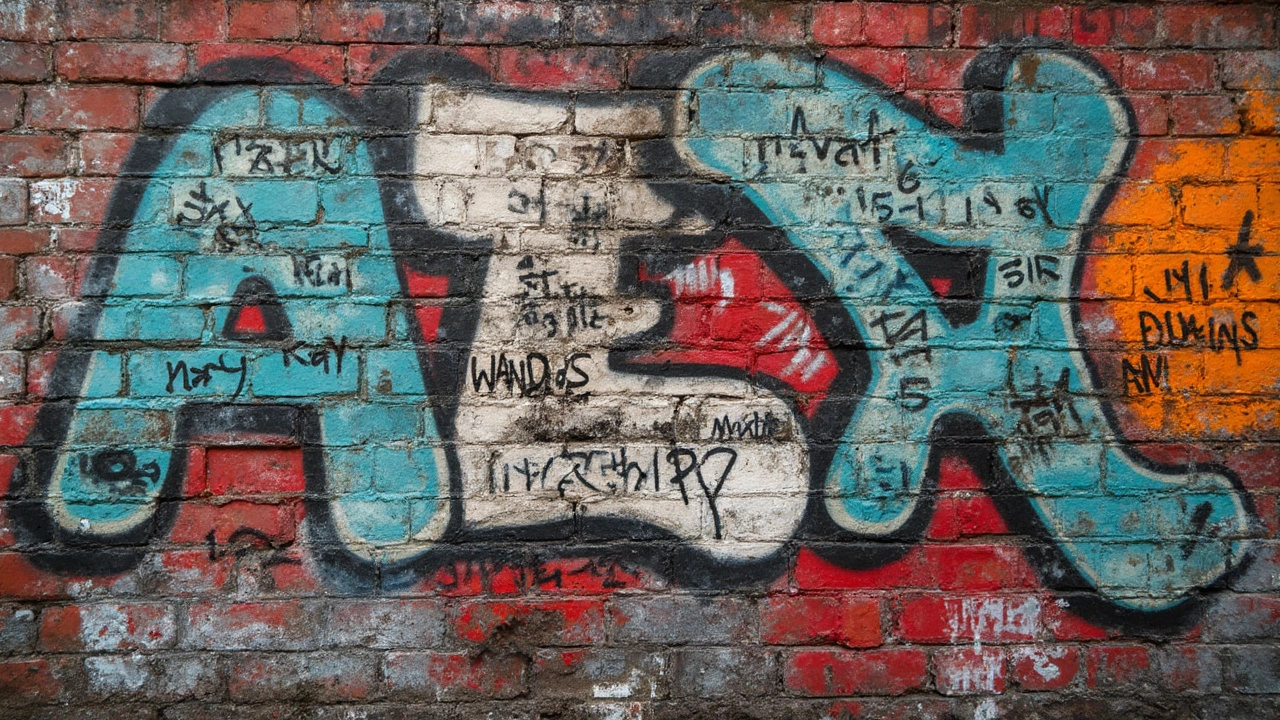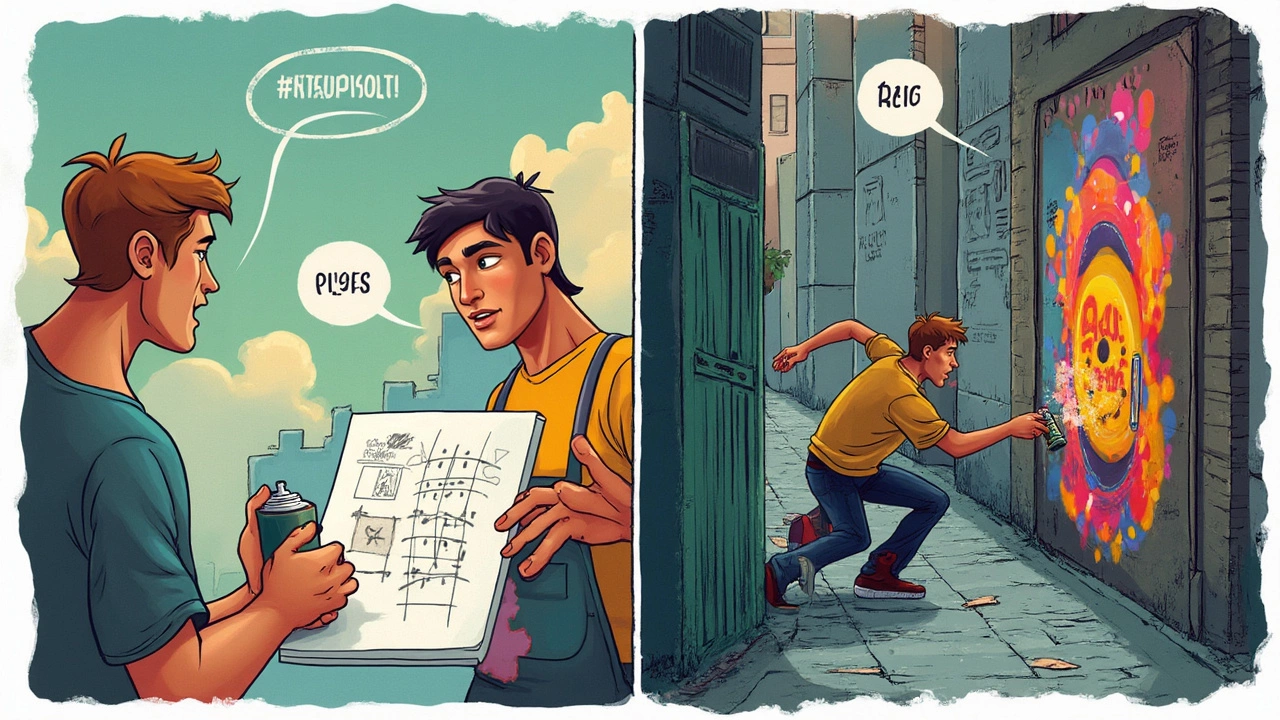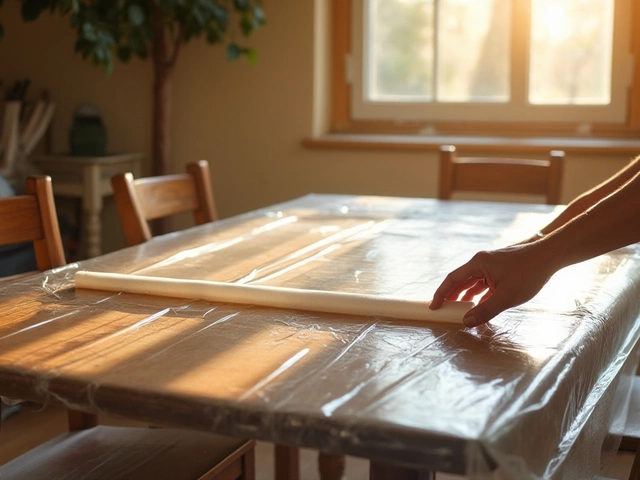
If you’ve ever walked around a city and spotted colorful shapes, big letters, or wild murals where nobody asked for them—yup, that’s what most folks call graffiti. It’s the umbrella term for illegal wall art, even though some people toss around words like vandalism or street art. Graffiti isn’t just about scribbles. Sometimes, it’s detailed masterpieces painted under the cover of darkness.
The big thing to know? If it goes up without permission, it’s considered illegal, no matter how amazing it looks. Laws treat it just like tagging or even writing your name with a marker on a wall. The reason cities get strict about it is simple: they see it as property damage. Doesn’t matter if it’s a tiny signature or a whole block-long mural—the law makes no difference.
- The Real Name: Graffiti vs. Street Art
- Why It’s Illegal
- Famous Cases and City Responses
- Tips for Legal Wall Art
- How Urban Artists Stay Safe
The Real Name: Graffiti vs. Street Art
Most people hear the word graffiti and think of quick tags, bubble letters, or spray-painted words on trains and alleyways. That’s right: if it’s put up without permission, it usually falls under graffiti. But there’s more going on in the scene. Some artists create complex murals, stencils, or even full-on paintings—often called street art—even though it’s still considered illegal if they don’t have the okay from whoever owns the wall.
Here’s what gets confusing: Not all street art is illegal. There’s a fuzzy line between what gets you in trouble with the city and what ends up on Instagram as a public masterpiece. Graffiti almost always breaks the law if it’s done without permission. Street art, on the other hand, can be both legit (on designated walls or with permits) and illegal (anywhere else).
Check out this quick breakdown:
| Type | Usually Illegal? | Main Features |
|---|---|---|
| Graffiti | Yes | Tags, throw-ups, bubble letters, fast execution |
| Street Art | Sometimes | Murals, stencils, posters, detailed work |
One thing these forms have in common: if you spray, draw, or paint on a wall without the owner’s nod, the law doesn't care if it’s a quick scribble or a detailed portrait. It’s all the same in their book.
Want to spot the difference in real life? Here are a few tips:
- Graffiti writers use signatures (tags), crew names, or coded messages. Usually quick, usually with spray paint or markers.
- Street artists go for images, animal shapes, or big characters and sometimes use tools like stencils, paste-ups, or even stickers.
- If it looks rushed, it’s probably graffiti. If it’s super detailed or took hours, it might be street art (but still possibly illegal!)
Bottom line: Illegal wall art goes by lots of names, but graffiti and street art are the big ones. The real divide? Whether permission was given or not.
Why It’s Illegal
Here’s the deal: putting up illegal wall art on someone else’s property is treated just like any other form of property damage. As soon as paint or a marker touches a wall you don’t own, you could be breaking the law. That’s why police and city officials call graffiti a crime almost everywhere in the world, even if it’s artistic.
The main problem is consent. If the building owner didn’t say yes, putting anything on their wall—no matter how cool it looks—isn’t just rude, it’s against the rules. Cities also spend a ton on cleaning it up. In Los Angeles alone, experts say the city shells out over $7 million each year just to remove graffiti from public spaces. That’s money that could have gone to schools or parks.
Some cities take it super seriously. If you get caught spraying graffiti in Singapore, you might have to pay a big fine, face jail time, or even get caned (which is exactly what it sounds like). In New York, you could end up with a criminal record. Repeat offenders can get hit with higher penalties—think thousands in fines or even jail time.
| City | Max Fine | Jail Time Possible? |
|---|---|---|
| Los Angeles | $1,000+ | Yes |
| London | £5,000 | Yes |
| Singapore | $2,000 SGD | Yes (plus caning) |
If you want to make large-scale urban art legally, you need permission. Some places even have ‘free walls’ where artists can paint legally, turning the whole idea on its head. But anywhere else, spraying or tagging can land you in big trouble quick.

Famous Cases and City Responses
When it comes to illegal wall art, some artists have become legends for their guts and skill—even though most of their work popped up where it wasn’t supposed to. One of the most famous is Banksy, the British street artist. He’s managed to pull off massive murals in places like London and New York without ever getting caught in the act. In 2015, Banksy turned an entire seaside resort in the UK, Dismaland, into a pop-up art event— police and city officials didn’t try to shut it down, but most of his other pieces have been painted over or removed pretty quick.
New York City is basically the birthplace of modern graffiti. Back in the ’70s and ’80s, subway cars became rolling canvases. Names like TAKI 183 and Dondi White showed up everywhere. The city spent millions trying to scrub trains and crack down on spray paint sales, even passing laws so you had to be 18 to buy cans.
Here’s a quick look at how different cities have responded:
- New York, USA: Created a dedicated "Vandal Squad" in the NYPD. After a big cleanup campaign in the 1980s, subway graffiti dropped by about 85%.
- Melbourne, Australia: Changed laws so police could search for spray cans without a warrant, and launched public "graffiti hotlines."
- Berlin, Germany: Has both a tough fines system (artists can be billed for clean-up) and special legal walls where street art is encouraged.
- Bristol, UK: Actually named one street after Banksy, and lets artists paint murals in certain zones.
This table breaks down how some major cities tackle graffiti:
| City | Penalty/Fine | Unique Approach |
|---|---|---|
| New York | Up to $2,500 or jail | Strict police squads, bans on spray paint sales |
| Melbourne | Up to AUD $36,000 | Hotlines, random searches, community murals |
| Berlin | Up to €2,000 | Legal walls, tough fines, tours of street art |
| Bristol | Up to £5,000 | Banksy walking tours, mural zones, community cleanups |
Cities have learned that simply erasing graffiti doesn’t always work. Some have started offering legal walls, mural projects, or workshops. But paint where you shouldn’t, and you’re looking at big fines—or worse.
Tips for Legal Wall Art
If you’re itching to put your art out there without running from the law, there are plenty of ways to go legit. Plenty of cities actually want people to do mural work or creative painting, but the trick is you need to ask first. Start by finding out if your city has a "legal wall" program or places where wall painting is encouraged. Cities like Melbourne, Berlin, and even New York have specific spots open for public art. Some towns even run annual mural festivals and call for artists to join in.
If you’ve got a spot in mind, just contact the property owner. Most businesses love colorful outdoor art because it can stop taggers and even draw customers. Grab a letter of permission or a short contract—seriously, it’s way better than risking fines. You can also look for non-profits and art groups; a lot of them team up with local authorities to organize legal painting events.
Here’s a quick, no-fuss breakdown to keep your illegal wall art dreams strictly above board:
- Check city websites for public art programs or mural application guides.
- If it’s a business or private wall, talk to the owner and get everything in writing.
- Apply for any city permits if required. Some places have online forms—takes about 10 minutes.
- Join art collectives, since they often get first dibs on big walls or city-funded projects.
- Keep paint tidy. Even with permission, making a mess with drips or paint on the sidewalk can get you booted from a project.
- Show a sketch first. Owners and city programs usually want to see the plan before you paint.
Let’s look at how much getting caught vs. going legit can impact you:
| Aspect | Illegal Wall Art | Legal Wall Art |
|---|---|---|
| Fines | $250–$5,000 (in major U.S. cities) | $0 |
| Materials Cost | Artist covers all costs | Sometimes supplied or reimbursed |
| Visibility | Hidden or quickly removed | High, can last for years |
| Risk of Arrest | Yes | No |
Legal wall art doesn’t just keep you off police radar—it builds your portfolio and can even earn you cash for your next project. Just follow the steps, and you can make a real mark without dodging trouble.

How Urban Artists Stay Safe
If you look into the world of illegal wall art, it’s obvious that artists take safety seriously—not just for their art, but for themselves. Because spray-painting a wall at 2 a.m. is way different from painting a canvas in a studio. Most urban artists are clear about one thing: getting caught rarely ends well, and they plan ahead to avoid legal trouble or personal harm.
First, artists scope out locations carefully. They pay close attention to security cameras, foot traffic, and how long it takes cops or security to swing by. Some even use Google Maps to size up walls and alleys before leaving the house. Timing is everything—late at night or super early in the morning is the sweet spot since fewer people are around.
- Dress code matters: Baggy clothes for easy movement, hoodies to hide their identity, and sometimes gloves to avoid leaving fingerprints.
- Quick tools: Spray paint is their go-to because it’s fast, but some carry stencils or fat markers for a quick hit and run.
- Lookouts: Some artists bring friends to spot trouble or distract passersby.
- Exit plan: Before touching a wall, they map out a fast escape route. If things go bad, blending in with the crowd helps.
It’s not just the law they worry about. Breathing in fumes from spray paint can add up, so a lot of artists use cheap masks or bandanas. The smarter ones carry water and first-aid basics in case something goes sideways, like a nasty fall from climbing fences or walls.
| Safety Tip | Why It Matters |
|---|---|
| Wear a mask | Reduces risk of inhaling toxic paint fumes |
| Scout the area first | Helps avoid cameras and police patrols |
| Use fast-drying paint | Speeds up work and limits exposure time |
| Bring a lookout | Extra eyes can warn about security or passersby |
Here’s something wild—a 2023 report from the National Association of Urban Art found that 72% of artists who had never been caught had a lookout with them and spent less than 15 minutes on each piece. Planning pays off. If you’re thinking about trying your hand at illegal wall art, know the risks. Most artists work on practice boards at home first, or they find legal graffiti walls in some cities to master their skills before hitting the streets.



